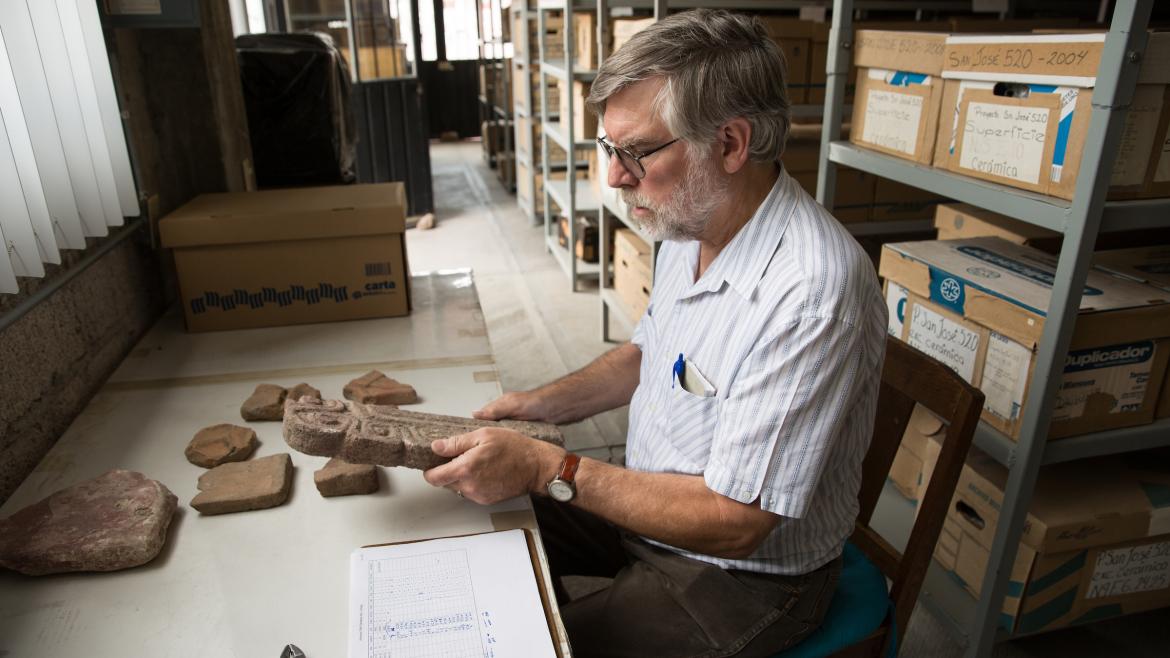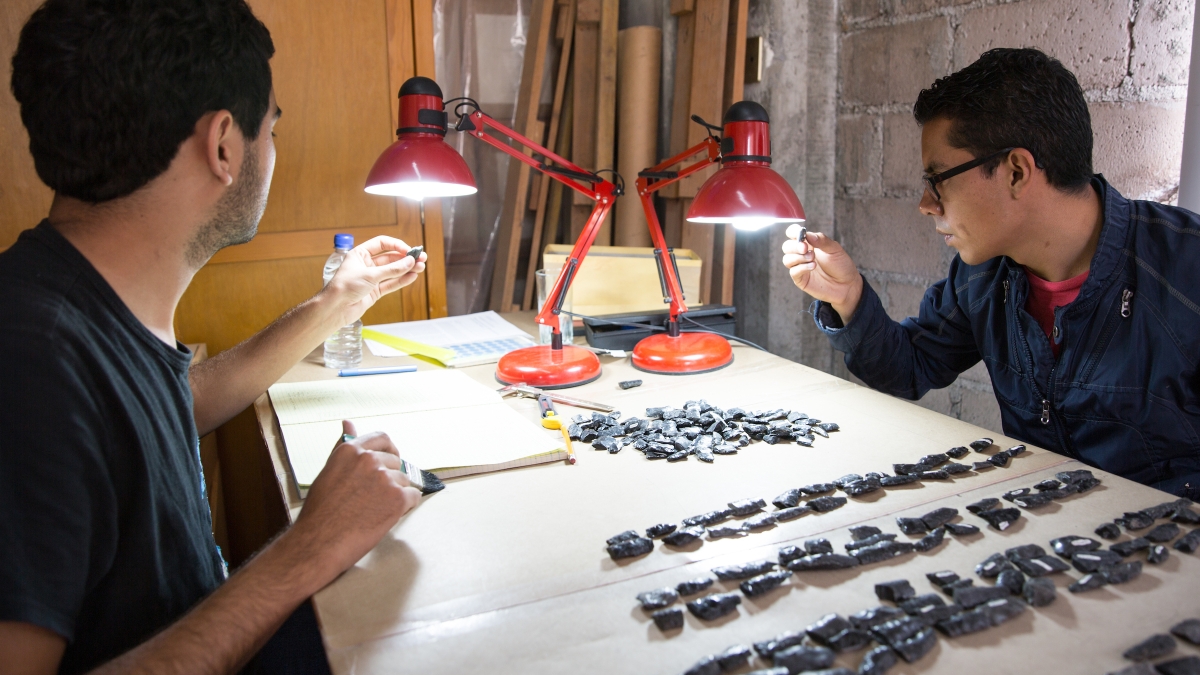Editor’s note: This is the second in a three-part series about ASU’s Teotihuacan lab. Click for the first and third installments. Lab director Michael E. Smith will appear Wednesday in Tempe to talk about new discoveries; find event information at the bottom of this story.
It’s 7:30 a.m., and about eight archaeologists from six universities are loading up instruments, backpacks, surveying instruments, water jugs, buckets and tripods into a big gray van.
“We start early,” says one of the student archaeologists, “and we finish late.”
They pull gray tarps and shovels from a tool storage shed. The Arizona State University Teotihuacan Research Laboratory complex doesn’t look that big, but there are storage spaces and workspaces tucked in every corner. They all wear hats (even though it’ll only be 76 today, the city is at high altitude and the sun gets intense) and boots (the ground is rough, and digging turns up lots of rocks).
The van backs out of the complex. Lab director Michael Smith comes out of his guesthouse.
“Oh man, I wish I was going,” he says as he watches them go.
No other university has a lab at Teotihuacan. This year it turns 30. ASU professor emeritus George Cowgill, the world’s top authority on the ancient city, took over the facility in 1986.
From the street it looks like a CIA black site: towering gray walls, a black steel gate, and a buzzer high out of kid reach. No ASU logo, seal or Sparky.
The main two-story building is devoted to storage and workspaces, with desks under the windows and row after row of boxes that rise to the ceiling and fade into the dark. With an estimated 10,000 boxes of artifacts from excavations as old as 40 years ago, this is the heart of the lab.
The complex has a row of tiny guesthouses that lead back to what is affectionately called the Old House. It contains living quarters for students and visiting scholars, a dining area and kitchen (sign over sink: “Due to budget cutbacks we had to fire the maid. Do your own dishes”), and a small library of airport paperbacks (“If there’s anything classy in there, it belongs to George Cowgill,” Smith said). The living quarters are bare bones; it’s not a resort.
A side office has a trestle table packed with computers, scanners, filing cabinets, and shelves laden with binders and yellowed stacks of reports dating back to the early 1960s. ASU research professor Saburo Sugiyama uses it as an office when he’s in town. No one’s really sure what’s on the shelves.
“I don’t even want to look at it,” Smith says.
Graduate students from a handful of American and Mexican universities pack a van full before going out to dig sites at Teotihuacan.
Top photo: Archaeologists David Camacho (right) of the Universidad Autónoma del Estado de México and Fidel Cano Renteria of MIT look for color differences in obsidian knife points at the ASU Teotihuacan Research Laboratory in Mexico. Photos by Ken Fagan/ASU Now
Cooperation among scholars and nations
The archaeology lab is an example of ASU’s engagement with Mexico.
“We’re in San Juan Teotihuacan, and we have Mexican employees here in the lab, and a lot of Mexican archaeologists use the lab — colleagues use the lab here,” Smith said. “On the current fieldwork project, there are probably more Mexicans than Americans working on that project. It’s a setting for cooperation between U.S. and Mexican students and scholars and workers. It’s a real part of ASU’s outreach to foreign countries, and Mexico in particular. I think people like working here.”
The lab is a resource for many different universities and projects studying Teotihuacan and other nearby sites. In June, there were researchers and students from Penn State, Boston University, George Mason University, Harvard, MIT and the National University of Mexico as well as ASU.
“Right now we have a group from MIT looking at our obsidian,” Smith said. “We have a group from the National University of Mexico looking at some of the mural paintings here. It’s quite extensive, the number of projects from around Mexico and the U.S., that use our facilities here.”
Oralia Cabrera Cortés is the lab’s director of operations. She studied under Cowgill at ASU, earning both her master’s and doctorate.
Scientists and students contact the lab to find out what’s in the collection, then the requirements to study the collection. They file a research proposal with their credentials, intentions and project objectives. Typically they come in the summer, but the lab is open all year.
After visiting scholars do their analyses, they provide the lab with reports and copies of their theses. They have about 70, most relating to the Teotihuacan Mapping ProjectBecause of its combination of scale and detail, the Teotihuacan Mapping Project is the one of the best maps of any ancient city. It shows where artifacts were found, leading to an understanding of how the city functioned. Archaeologists call it “indispensable” for planning work at the city. It was initiated by professor René Millon of the University of Rochester, who directed the detailed mapping of the entire city in the 1960s, combining air photos and mapping with surface reconnaissance of more than 5,000 buildings, making notes on visible features, and collecting nearly a million pottery fragments and other ancient objects from the buildings, but also some from excavations of the Feathered Serpent Pyramid.
Keeping collections is crucial to understanding the history of Teotihuacan, Cabrera said.
“It’s also a very costly activity,” she said. “The INAH (Instituto Nacional de Antropología e Historia / National Institute of Anthropology and History) is the institution in the country that curates and is in charge of facilitated research in archaeology in Mexico. They do have a series of facilities across sites and states. They try to maintain as much as they can. But to maintain collections requires a lot of space that sometimes is not possible to have — and a lot of money too.”

ASU professor and lab director Michael Smith looks at an almena, or roof ornament, at ASU's Teotihuacan Research Laboratory in Mexico.
Photo by Ken Fagan/ASU Now
Maintaining boxes and collections also diverts funding from more research, Cabrera said. Typically a collection is studied and returned to the INAH, which doesn’t always have the money to store and curate them. New advances in technology mean much can be gleaned from old excavations.
“By keeping these collections here, we have been able to prove that, even with collections that had already been studied partially, there are new techniques in archaeology all the time,” she said. “We are able to continue to extract information that has been very useful to the history of the city. Only by keeping these collections available to everyone who is able to come up with a project, we are able to continue this research.”
Life cycle of a lab
The lab, part of the School of Human Evolution and Social Change in the College of Liberal Arts and Sciences, began under professor René Millon of the University of Rochester as a headquarters for the Teotihuacan Mapping Project in the 1960s.
ASU research professor George Cowgill took over as director of the lab in 1986 after Millon retired. Around 1987 Cowgill got a grant to build the current lab building from the National Science Foundation. Then he got another grant to expand the lab and put a second story on it.
The lab moved from housing artifacts from the Teotihuacan Mapping Project to storing artifacts from other digs.
“Because we’re curating the artifacts — we’re keeping them, we’re keeping them in good order, we’re keeping track of them — it allows researchers to come back long after the fieldwork and apply new methods and learn new things from them,” Smith said. “That’s one of the main values of the lab — it’s a resource.”
Boston University assistant professor of archaeology David Carballo has worked at the lab for 17 years.
“I really got my start in Teotihuacan archeology through this lab,” Carballo said. “I started in 1999 with the Moon Pyramid project. I’ve been coming back off and on since. It’s an unparalleled resource for researchers of this city, and there’s new generations being trained all the time.
“Teotihuacan lives on in archaeology very much because of this lab and ASU’s efforts to maintain it and keep it going. All of my collections from the Tlajinga project are housed here. I can come down here with students and analyze them. We have storage space. We have space to analyze things. . ... Here we have many, many decades of minutiae of life at Teotihuacan. It can continue to be studied by coming generations.”
The lab is beginning to groan at the seams. It’s full, and it needs to expand. One of Carballo’s digs this summer yielded three to four boxes of artifacts for every 20 centimeters. (“No wonder the lab is full,” Smith commented.)
“You can see these boxes right here,” Smith said. “They’re sort of at the ends of shelves. ... With the new project, we don’t have any room to expand.”
Immediate needs are for more work and analysis space. The rule of thumb in archaeology is that every month of digging requires two to four months of artifact study. Add to that the march of technology. With new techniques, the lab’s collection still has much to offer in terms of discoveries.
“I’d like to see (the lab) continue to do what it’s doing and do it better,” Smith said.
Hear Smith speak in Tempe
What: "New Views of the Ancient City of Teotihuacan" lecture.
When: 6-8 p.m. Wednesday, Aug. 31.
Where: Alumni Lounge (Room 202), Memorial Union, Tempe campus.
Details: Free and open to the public. Find more at the events site.
More Science and technology

Hack like you 'meme' it
What do pepperoni pizza, cat memes and an online dojo have in common?It turns out, these are all essential elements of a great cybersecurity hacking competition.And experts at Arizona State…

ASU professor breeds new tomato variety, the 'Desert Dew'
In an era defined by climate volatility and resource scarcity, researchers are developing crops that can survive — and thrive — under pressure.One such innovation is the newly released tomato variety…

Science meets play: ASU researcher makes developmental science hands-on for families
On a Friday morning at the Edna Vihel Arts Center in Tempe, toddlers dip paint brushes into bright colors, decorating paper fish. Nearby, children chase bubbles and move to music, while…


